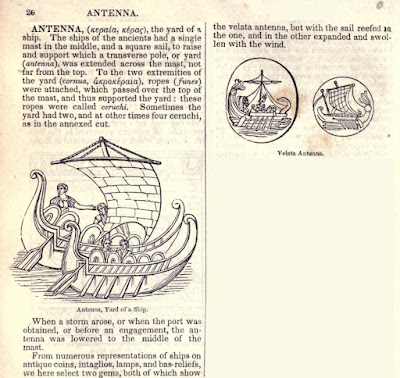Key vocabulary discussed in earlier posts is highlighted but not discussed. Comenius goes into considerable detail about the parts of 17th century vessels, which may appear quite specialised, but many of the Latin words are common and were all used in relation to ships. I have omitted a couple of small sections where the vocabulary is too rare to be of any value.
[1]
A Merchant-ship
│ Nāvis onerāria
A ship is
driven onward not by oars, but by the sole force of the
winds.
Nāvigium impellitur, nōn rēmīs, sed sōlā vī
ventōrum.
[i] Image #1: late 17th
century Dutch cargo vessel, described as a nāvis mercātōria, the term
used by Plautus:
Ībō in Pīraeum, vīsam ecquae advēnerit / in portum ex Ephesō nāvis mercātōria
│ To the Piraeus will I go;
I'll go see whether any merchant-ship has come into harbour from
Ephesus.
[ii] vīs, vīs [3/f] can be misread, especially in the plural
the word means ‘force’, ‘power’, ‘strength’, ‘violence’, but it is often used in the plural: vīrēs (strength; physical force) and looks similar to virī (men) but they are completely different words
Image #2: vīs
is also an example of a defective noun which refers to a noun where not all
the case endings are attested in Classical Latin; the English verb “can” is
defective since there is no infinitive “to can”, “to be able” being used
instead of the original Anglo-Saxon infinitive cunnan (Modern German:
können)
[iii] impellō,
-ere, impulī, impulsus [3]: drive, push forward
Nāvigium impellitur
│ a ship (vessel) is pushed / driven forward
[2]
In it is
a mast set up, fastened with shrowds, on all sides to
the main-chains, to which the sail-yards are tied, and
the sails to these, which are spread open, to
the wind, …
In illō mālus ērigitur,
firmātus fūnibus, undique ad orās nāvīs, cui annectuntur antennæ,
hīs, vēla quæ expanduntur, ad ventum ...
The beak
is in the fore-deck. │ Rōstrum est in prōrā.
[i] Passives:
Mālus ērigitur
│ a mast is set up
firmātus ¦
fūnibus │fastened by /with ropes
vēla expanduntur
│ the sails are spread open
annectuntur
antennae │ the sail-yards are tied
[ii] Careful!
mālus, -ī [2/m]:
mast of a ship
mālus, -ī [2/f]:
apple tree
malus, -a, -um:
evil, bad
mālum, -ī [2/n]:
apple
malum, -ī [2/n]:
evil, misfortune, wrongdoing
[iii] shrowds
(archaic) = shrouds = the ropes that are tied around a mast = Latin: fūnis, -is
[3/m], the general word for a rope or a cord
[iv] antenna (CL: antemna),
-ae [1/f]: sail-yard, the horizontal spar or shaft to which a sail is attached
on a sailing vessel, used to spread and support the sail
Image #3: antenna from: A
school dictionary of Greek and Roman antiquities (Smith, William, Sir,
1813-1893)
[v] It’s
interesting that in the 17th century, English is still using the
word “beak” or “beakhead” i.e. the literal translation of Latin rōstrum
which refers to the protruding part of the foremost section of a sailing ship
[vi] An extract
from Livy describing Scipio’s tactics during a naval battle:
Scīpiō … onerāriārum
quadruplicem ōrdinem prō mūrō adversus hostem opposuit │ Scipio … placed
four lines of transport (ships) as a bulwark (“wall”) against the
enemy.
The passage goes
on to describe how Scipio prevented this line of transport ships from being
broken in battle:
malīs antemnīsque ¦ dē nāve in nāvem ¦ trāiectīs
ac validīs fūnibus velut ūnō inter sē vinculō inligātīs
with masts
and (sail-)yards crosswise ¦ from ship to ship ¦ lashed
together with stout ropes as if by a single cable (vinculum,
-ī [2/n]: chain, link, cord i.e. anything used for binding).




No comments:
Post a Comment